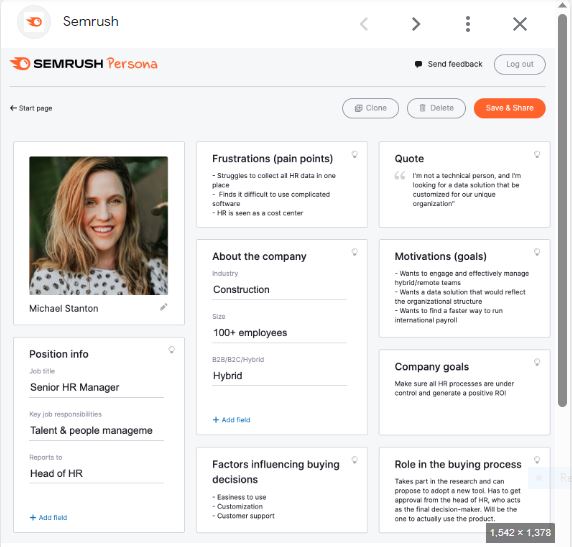Audience Research Tools That Empower Content Teams
If articles aren’t landing, your B2B Marcom team might be missing an essential step. Campaigns fizzle out before filling seats in your upcoming webinar. Emails sit, social posts get little engagement, and the new blog series fails to drive sign-ups.
Now, you’re scrambling, wondering how this could happen.
You’re not alone. Most marketers rarely conduct audience research. In a Content Marketing Institute survey, surprisingly only 35% do. But, if you want to create remarkable content says Co-Schedule, you must target the right audience. “Your team could spend 30 hours or more on a single piece,” but without being laser-focused, it won’t move the needle.”
Unsurprisingly, the teams who conduct audience research have been 303% more likely to achieve their marketing goals 80% of the time, according to Co-Schedule’s survey of 1,500 top marketers.
It comes down to one key question.
How well do you know your target audience?
Part one of this series focuses on why to revisit personas. It provides easier, faster, and more cost-effective ways for B2B marketers to build better personas to understand their ideal business customers.
In part two, we’ll explore how to select the right audience intelligence tools to sharpen your messaging and drive engagement, growth, and conversions. This will help you understand how your business customer evolves as workplace priorities shift.
Digital Persona Templates Help You Organize And Share Customer Data
Below are persona templates to create reality-based buyer personas. Notice how the data is organized, which information is included, and what’s left out. Select the template that works best for your team.
Wynter persona template with guiding questions, categories, and features

There is no headshot because the company asserts that random images can introduce bias. Your skewed data set will exaggerate the biases.
This template uses the “4-R Persona” framework:
- Roles
Primary persona’s role - Responsibilities
Top three - Rituals
- Relationships
Uncover who influences the decision-making process most
Who do they report to, manage, and supervise?
Pain Points and Frustrations?
What is your business consumer most worried about or lacking? - Goals and Motivations
What do they want to increase or build? - Options to add:
Career journey
Social networks
How and where they might interact with your brand
Sources of customer’s information (people and brands they trust)
Semrush persona template and approach
The Semrush persona includes rich details about the company, factors influencing the buying decision, role in the buying process, and a quote that captures the persona.

Persona resources
View this video to create a free Semrush persona or learn more about Semrush’s template.
HubSpot persona template
It includes often overlooked categories:
- Social networks
- Preferred method of communication
- Tools needed to do their job
- How they gain information
Try HubSpot’s fun template to generate a buyer persona! Check out the preview image below.

Smart Audience Research Tools Streamline Processes
Leverage your first-party CRM data
Your Customer Relationship Management (CRM) data is “filled with a treasure trove of first-party data from people who want to connect with your brand,” asserted Ann Gynn, Managing Editor of The Tilt, and Editorial Consultant for The Content Marketing Institute.
That’s why you should begin your research by “looking at who’s already buying, communicating, and connecting with the company. A collaborative CRM can ground that analysis.”
“By analyzing actual customer and prospect data through the CRM, marketers understand the people and their behavior in the middle and bottom-of-the-funnel goals. Creating personas in those stages of the buyer’s journey better serves your most captive C-suite audience.”
Ann Gynn, Managing Editor of The Tilt
The CRM is designed to take all those customer touch points into a centralized system unless the person takes steps to avoid it, Gynn explained.
She leads us through the short version: If they subscribe and use the same e-mail address to purchase, that’s the direct route. It also tells me the open and click-through rates. They clicked on these topics and ultimately converted after watching the webinar. So, now with those two touchpoints, you can map behavior to understand it.
Dig deeper to maximize first-level RCM data
CRMs allow you to “map the path potential customers take from their first entry point in the system to their post-purchase activity (or where they exit the path before buying).
“With that first-party data, you have a better foundation to conduct additional persona research,” Gynn said. “You understand where to go and what to look for. You can identify people in the ideal customer profile to interview to flesh out the persona.”
But often it’s not a direct route. You must dig deeper to maximize your first-level RCM data.
Then she asks: What if I’m giving a talk? I would want to know more than who opened the email and the click-throughs, the standard broad measures of success. I want to know what they do right after they open it. Or, what they do three months later. Today, you can pull reports and get even more technical.
The information is available. But it’s not shared because it hasn’t been assigned to anyone. In many businesses, it’s not routine to streamline the data into content development or persona development.
It’s not done until a problem within the company occurs. A major disruption is coming by mid-2024, as Google crumbles third-party cookies. But she feels businesses can prepare today.
She believes that B2B companies miss out by not having an audience data person to review it regularly.
Create a low-tech CRM workaround
If you can’t invest in a CRM, Gynn advises doing a low-tech version. Conduct qualitative interviews with customers in your database.
Ask what you want to know:
- What are their content consumption habits?
- How do they find information about your industry, services, and products?
- What are the top questions?
Use these word cloud app tips to analyze data:
- Put your interview transcription into a word cloud tool to highlight word patterns.
- Conduct qualitative surveying of the customer or prospect database.
- Use this process whether you have created personas or are starting to document them.
- This process works best for a business with an established customer base focused on marketing to that audience.
Generate an automated persona
What is Reveal?
Reveal is an AI-powered tool that analyzes your existing marketing, sales, and product data to “reveal what attributes and actions are the best predictors of revenue,” explained Tory Wenger, Breadcrumbs.io, Marketing Manager.
Why was it developed in 2022?
According to Wenger, Reveal was developed to analyze all your customer data stored in the database to generate an ideal customer profile based on the most successful ones to understand your target audience based on actual data.

How is this tool helpful for B2B content marketers?
This predictive tool saves time by taking the guesswork out. “Reveal lets you know where gaps in your data collection process exist. These insights typically can’t be found in any CRM. It is difficult to diagnose with a large volume of contacts.”
How can you leverage manually collected data with an AI-powered tool?
Think of AI tools as an extension of your team, “not a complete replacement for any marketer or salesperson. AI allows us to augment and expedite the process considerably.”
How can you leverage manually collected data with an AI-powered tool?
Think of AI tools as an extension of your team, “not a complete replacement for any marketer or salesperson. AI allows us to augment and expedite the process considerably.”
“Manually collected data can be rife with formatting issues or typos, making it hard to sift through and analyze quickly,” Wenger said. “AI-backed tools can easily solve these issues and work on the parts of the process that require a more human approach. That validates the results so you can personalize content.”
Amass accurate, actional data at scale

What is SparkToro?
“SparkToro is an audience research tool that indexes public data from 100s of millions of web and social profiles,” explained Rand Fishkin, Co-Founder of Spark Toro, and Founder of Moz.com. “Then it aggregates and anonymizes the data so anyone can do web-scale market research in seconds.”
“It helps marketers, creators, PRs, researchers, and business owners uncover the behaviors and demographics of any online audience.“
Rand Fishkin, Co-Founder of Spark Toro, and Founder of Moz.com
How is this tool helpful for B2B content marketers?
This digital tool “takes time-consuming, hard-to-access information that’s already available on the web and makes it accessible” to help teams with smaller budgets and fewer resources.”
According to Fishkin, the biggest advantage SparkToro gives for persona building is how users can get fast, accurate, and actionable data at scale. Product and marketing teams will no longer receive personas that are rough stereotyped outlines of fictional human beings
“SparkToro lets researchers add information like what content managers watch, words they use to describe themselves, keywords they search for, and dozens of other data points to enable marketers to improve how they serve and reach that group,” Fishkin said.
AI insight-driven content strategy

What is Google Analytics 4 (GA4)?
GA4, the replacement for Universal Analytics, tracks user website activities. “It has an embedded AI-insights panel that goes beyond recognizing trends and predicting gaps to give you a deeper understanding of your customer’s behavior,” said Gresham Harkless, Founder of Blue 16 Media. Artificial Intelligence insights inform decision-making and provide a real competitive advantage.
How is this tool helpful for B2B content marketers who conduct market research?
The upgraded dashboard makes it easier, faster, and more intuitive to extract audience data. He walks us through a comparison of GA and GA4.
“Before with Google Analytics to get certain recommendations of what you should do next or what to avoid, you had to go deep into the data,” Harkless said. “Let’s say there’s a page on your client’s website that’s performing well. Before when you signed into the Google Analytics dashboard, you wouldn’t see that immediately. But with this new dashboard in GA4, you get instant insights and thoughtful questions to guide the research process.“
Remarkable Content Empowers Teams And Your Business Consumers
Creating compelling content begins with data-driven documented personas, easily edited and shared with your team. This article presented digital strategic templates and audience research tools for small B2B marketing teams to work smarter, not harder.
Your business blog informs decision-making when you know what drives consumer behavior:
- What workplace issue challenges them most?
- Where do they go for advice?
- Who could influence their buying decision most?
With multiple stakeholders involved in the decision-making, developing the right content is challenging. What impacts your content strategy most is having smart tools that evolve with your consumer as priorities shift at work and habits change.
Looking for the opportunity to meet and mingle with other marketing professionals? Join us for an evening of drinks, nibbles, and networking!
This is your chance to connect with fellow marketing minds in a relaxed and fun setting. Come expand your network, share ideas, and make some new connections!
Lynda Dell is the AMA Philadelphia Marcom blog editor and content strategist, a web copywriter for B2B, health brands, ed publishing, and learning markets to become a sought-after online resource driving sales and growth. When not writing and developing content, you can find her exploring Grounds for Sculpture in Hamilton Township, NJ, going on nature hikes, and bingeing on personal development podcasts.
